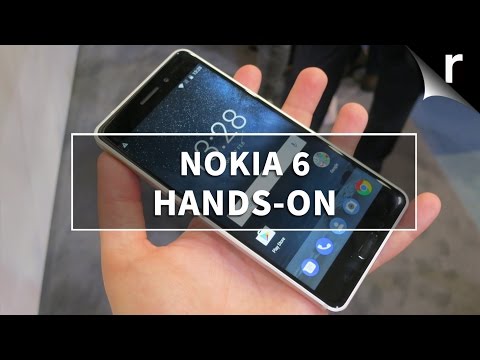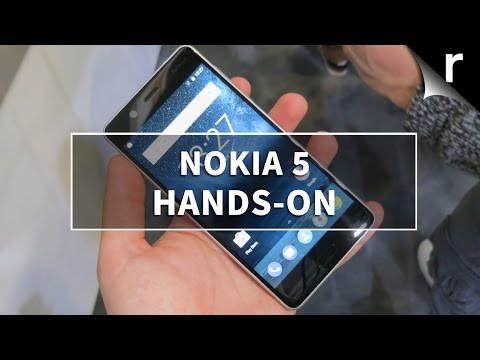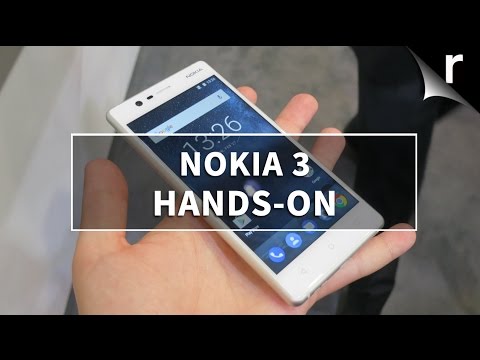We compare the three new Android smartphones from Nokia, the Nokia 3, Nokia 5 and Nokia 6, to see how they stack up in terms of specs, performance, features and camera tech.
In 2017, Nokia is back with a bang, launching three new Android smartphones here in the UK (alongside a nostalgia-crammed remaster of the classic 3310 mobile).
The Nokia 6 is the more premium of the three handsets, featuring a sleek aluminium body for a touch of class, a mighty 5.5-inch Full HD screen and the latest version of Android Nougat on-board. You’ll find the same metal finish on the slightly cheaper Nokia 5, although that display has been scaled back to a 5.2-inch 720p panel. Meanwhile, the Nokia 3 is the cheapest of the bunch and also the most compact, with its 5-inch 720p screen.
All three Nokia Android handsets are at the affordable end of the pricing scale, starting from £120 here in the UK and rising to just £220 for the Nokia 6; although that handset is also available in a more expensive, premium model called the Arte Black.
Here’s how the Nokia 6, Nokia 5 and Nokia 3 compare when it comes to specs, cameras, speed and the other important bits. And if you’re after a new Nokia flagship phone instead, check out our coverage of the upcoming Nokia 9 handset.
Nokia 6 vs Nokia 5 vs Nokia 3: Specs
| Phone | Nokia 6 | Nokia 5 | Nokia 3 |
|---|---|---|---|
| Screen size | 5.5-inches | 5.2-inches | 5.0-inches |
| Screen resolution | Full HD (1920×1080) | HD ready (1280×720) | HD ready (1280×720) |
| Water resistant? | No | No | No |
| Fingerprint sensor? | Yes | Yes | No |
| OS | Android Nougat 7.1 | Android Nougat 7.1 | Android Nougat 7.0 |
| Processor | Snapdragon 430 | Snapdragon 430 | MediaTek 6737 |
| Memory | 3GB (Arte Black 4GB) | 2GB | 2GB |
| Storage | 32GB (Arte Black 64GB) | 16GB | 16GB |
| MicroSD? | Yes | Yes | Yes |
| Rear camera | 16-megapixel | 13-megapixel | 8-megapixel |
| Price? | £220 (Arte Black £280) | £180 | £120 |
Nokia 6 vs Nokia 5 vs Nokia 3: Design

Whether you go for the Nokia 6, Nokia 5 or Nokia 3, you can expect a Gorilla Glass screen and a tough-yet-sleek aluminum finish. In fact, all of these phones start of life as a block of 6000 series aluminium.
The standard Nokia 6’s full metal body comes in a choice of colours, including a fancy copper, matte black and tempered blue. That rear plate is smooth and clean, with no bands or breaks to ruin the pleasing aesthetics. You have a centrally-located camera that juts ever so slightly from the backplate and a simple Nokia logo, which complements the branding around the front side – you certainly won’t forget what make of mobile you’re rocking.
The Nokia 5 looks very similar in its layout and general design, although it is easier to hold because of the smaller screen, which makes for a more compact build. This slightly cheaper handset also features an all-aluminium body, albeit with a somewhat rounder finish. Therefore it’s a little less sleek than its more expensive sibling, at least in our eyes.
At the bottom of the range is the Nokia 3, which enjoys a metal core despite the fact that the back is constructed from a cheaper polycarbonate material. This means it feels less premium than the other two new Nokias, yet first impressions suggest that it’s nearly as solid and only slightly fatter than the Nokia 6.
We also have to give props to a special-edition Nokia 6 model, which has been designed to celebrate the worldwide launch of the phone. This version is called the ‘Nokia 6 Arte Black Limited Edition’ and features a high-gloss black backplate as well as some interior modifications. More on that later.
A fingerprint scanner is offered on the Nokia 6 and Nokia 5, although this isn’t found on the Nokia 3. All three devices are charged by a Micro-USB cable and can be used with headphones via the 3.5mm socket.
Dimensions (excluding camera bump)
Nokia 6: 154 x 75.8 x 7.85mm
Nokia 5: 149.7 x 72.5 x 8.05mm
Nokia 3: 143.4 x 71.4 x 8.48mm
Nokia 6 vs Nokia 5 vs Nokia 3: Screen and media

The Nokia 6 has the biggest display of the trio, at 5.5 inches. This is a Full HD panel, which means a resolution of 1920×1080 pixels, giving it a pixels-per-inch score of 403.
Meanwhile the Nokia 5 features a smaller 5.2-inch display and a 720p resolution (1280×720 pixels), giving it a lower pixel density of 282ppi. As for the Nokia 3, the display is the same resolution but only five inches in size, giving it a second-place density of 284ppi.
All of the new Nokias use the same IPS LCD panel and, as mentioned earlier, are protected by Corning Gorilla Glass to keep scratches and other damage at bay.
Unique to the Nokia 6 is a dual-speaker setup and Dolby Atmos support, which enhances its ability to play films and TV shows on the go. You can expect an improved audio experience, especially when rocking a pair of headphones, as Atmos adds some dimension to your video.
Nokia rates the Nokia 5 smartphone as the brightest (500 nits) compared to the Nokia 6 and Nokia 3 (both 450 nits). However, even those lesser models are still perfectly fine for outdoors use on a bright day, as we can testify from the time we’ve spent from the phones so far.
Likewise, all three phones can have their on-board storage expanded via a microSD memory card. That’s especially important for the Nokia 3 and Nokia 5, which only give 16GB of space – half of which is used up by Android and the other pre-installed apps.
Nokia 6 vs Nokia 5 vs Nokia 3: Performance and battery life

There is little difference between the Nokia 6 and Nokia 5 when it comes to everyday performance, as both use the Qualcomm Snapdragon 430 chipset. The Nokia 6, however, comes with 3GB of RAM (4GB in the case of the Arte Black) instead of the Nokia 5’s slightly meagre 2GB. We’ve noticed a fair few stutters on the Nokia 5 during general use, which you won’t see anywhere near as often on the Nokia 6.
A MediaTek 6737 processor and 2GB of RAM is crammed inside the Nokia 3, so it is likely to prove noticeably slower than its pricier siblings. That certainly seems the case in our hands-on time. Still, at least all three handsets use a vanilla version of Android Nougat, so they aren’t bogged down unnecessarily by heavy overlays and pointless bonus features.
As for battery life, the Nokia 5 has a 3,000mAh capacity, which is also what you get on the Nokia 6. The Nokia 3 meanwhile sports a 2,650mAh capacity battery, although that smaller screen and energy-efficient processor means you should get just as long battery life. The Nokia 5 and 6 boast Quick Charge 3.0 support however, so they power up to almost full in just over an hour.
Nokia 6 vs Nokia 5 vs Nokia 3: Cameras

As you would expect, the Nokia 6 comes out top in the camera department. Its 16-megapixel snapper with f/2.0 aperture lens and two-tone LED flash should help it take pictures that make the grade, while the front-facing eight-megapixel wide-angle snapper, also f/2.0, will take care of selfies and video calls.
The Nokia 5 steps the main camera down to a 13-megapixel sensor, although retains the same dual-tone flash, f/2.0 aperture and Phase Detection Autofocus. You also get the same eight-megapixel front camera.
Photos taken on the budget Nokia 3 should look the least savoury, although the eight-megapixel camera and its f/2.0 aperture and LED flash combination could surprise. As for the front camera, this has the same resolution and f/2.0 aperture as its siblings.
All of the front-facing cameras feature a wide field-of-view of 84 degrees so you can get more people in a photo when holding it at arm’s length or perhaps more of your surrounding scenery.
Stay tuned for full reviews of the new 2017 Nokia handsets, coming soon.



